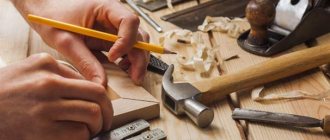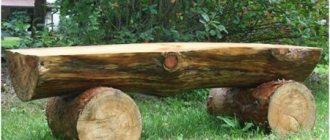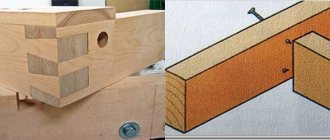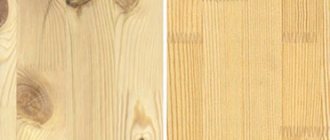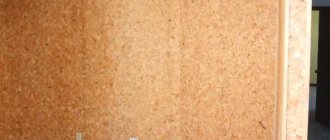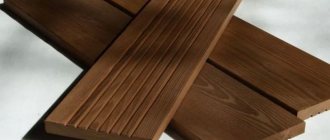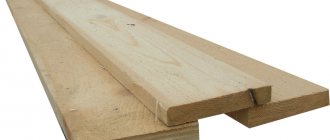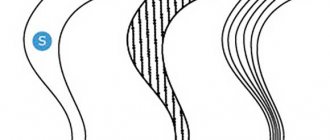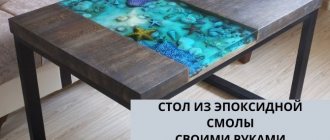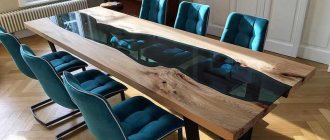Basic information
One of the most proven methods of connecting two parts is considered to be a tongue-and-groove connection.
This method of fastening wood products is the most widespread. It is used to fasten parts of window frames, doorways, various furniture elements, and the walls of wooden boxes. Each element of such products has a specially made tenon (or several pieces) or a groove (several grooves). The types of main connections of parts made of wood are defined in GOST 9330-76. This document defines the following characteristics of such fastening of wooden parts:
- rules for abbreviation (abbreviation) of various compounds;
- drawings showing the appearance;
- permissible dimensions of each element;
- the procedure and rules for determining the size of each element;
- expressions for calculating the dimensions of the required cutting tool;
- formula for calculating the strength of assembled elements;
- inspection procedure and strength testing.
GOST 9330-76 Basic connections of parts made of wood and wood materials. Types and sizes
According to this standard, all connections are divided into the following categories:
- corner (end and middle);
- box (mainly belongs to the corner category);
- along the edge;
- the so-called “on the mustache” length.
For each of these categories, the standard has its own abbreviation (short designation). This marking consists of two capital letters of the Cyrillic alphabet and one number. For example, UK-2 means that we are talking about a connection with a double open end-to-end tenon, UK-9 is a “mental” connection with a plug-in non-through round tenon. The entire list is set out in more detail in the text of the adopted standard.
Any type is accompanied by a detailed drawing. Each of them shows frontal and profile projections indicating dimensions, formulas for calculating each element, and finished results. To obtain a strong connection, the standard defines tolerances that must be observed in the manufacture of each element. The parameters of the corner tenon (its length, pitch and bluntness) are given in detail. Based on the results presented, the guest developed recommendations for choosing the necessary cutting tools. Separate references are made to other documents (standards) that determine by what means each of the listed products must be secured.
Types of finger joints
Today, a wide variety of such methods for fastening wooden parts has been developed. All types of tenon joints are classified according to the following criteria:
- number of spines;
- their form;
- eye depth (through or not);
According to the first sign, tenon joints are: single, double, multiple. It determines the number of fasteners produced. The main forms of the spike are:
- rectangular (has different lengths, pitch and apex angle);
- round;
- triangular;
- so-called “dovetail” (one-sided or two-sided);
- gear (with different angles of inclination);
- angular.
The choice of shape and size depends on the material used and the level of load that the entire structure must withstand. A tenon joint with many rectangular tenons has become widespread. Its main advantage is considered to be ease of manufacture and the ability to use it for any wood.
Gluing and fixing with clamps
Gluing and fixing glued parts is an important part of woodworking, without which many products will lose strength.
Adhesives
The glue strengthens the connection, holding the parts together so that they cannot be easily pulled apart. When working with adhesives, be sure to wear protective gloves and follow the safety instructions on the packaging. Clean the product from excess glue before it sets, as it can dull the plane knife and clog the abrasive sandpaper.
PVA (polyvinyl acetate)
PVA glue is a universal wood glue. While still wet, it can be wiped off with a cloth dampened with water. It perfectly glues loose surfaces, does not require long-term fixation for setting and sets in about an hour. PVA gives a fairly strong connection and sticks to almost any porous surface. Provides a permanent connection but is not heat or moisture resistant. Apply with a brush, or for large surfaces, dilute with water and apply with a paint roller. Since PVA glue is water-based, it shrinks when it sets.
Contact glue
Contact adhesive bonds immediately after application and joining of parts. Apply it to both surfaces and when the glue is dry to the touch, press them together. It is used for laminate or veneer to chipboard. No fixation required. Can be cleaned with solvent. Contact adhesive is flammable. Handle it in a well-ventilated area to reduce fumes. Not recommended for outdoor use as it is not moisture or heat resistant.
Epoxy adhesive
Epoxy glue is the strongest of the adhesives used in woodworking, and the most expensive. This is a two-component resin-based adhesive that does not shrink when set and softens when heated and does not creep under load. It is water-resistant and bonds to almost all materials, both porous and smooth, with the exception of thermoplastics, such as polyvinyl chloride (PVC) or plexiglass (plexiglass). Suitable for outdoor use. In an uncured form, it can be removed with a solvent.
Hot melt adhesive
Hot melt, solventless adhesive will stick to almost anything, including many plastics. Typically sold in the form of glue sticks that are inserted into a special electric glue gun. Apply glue, connect the surfaces and compress for 30 seconds. No fixation required. Can be cleaned with solvents.
Fixation clips
Clamps come in a variety of designs and sizes, most of which are called clamps, but usually only a couple of varieties are needed. Be sure to place a piece of scrap wood between the clamp and the work to avoid indentations from the applied pressure.
Gluing and fixation technique
Before gluing, be sure to assemble the product “dry” - without glue. Secure as necessary to check connections and dimensions. If everything is fine, disassemble the product, arranging the parts in a convenient order. Mark the areas to be glued and prepare clamps with jaws/stops set at the required distance.
Frame assembly
Using a brush, spread the glue evenly onto all surfaces to be glued and quickly assemble the product. Remove excess glue and secure the assembly with clamps. Apply even pressure to compress the joints. The clamps must be perpendicular and parallel to the surfaces of the product.
Place the clamps as close to the connection as possible. Check the parallelism of the crossbars and align if necessary. Measure the diagonals - if they are the same, then the rectangularity of the product is maintained. If not, then a light but sharp blow to one end of the post can straighten the shape. Adjust the clamps if necessary.
If the frame does not lie flat on a flat surface, tap the protruding areas with a mallet through a block of wood as a spacer. If this does not help, you may need to loosen the clamps or use clamps to secure a block of wood across the frame.
Marking
The marking largely determines the quality of the connection. In addition to the thicknesser and square, you will need an awl. When marking, it will leave a thin but clear groove.
First, mark the tenon, adding 2-3 mm for overlap.
Areas of parts to be removed are marked with light shading.
Remember: even a small mistake made during marking can seriously complicate the assembly of parts.
The markings are applied with a thicknesser and an awl. They draw a very thin but clearly visible line.
First, marking lines are applied with a thicknesser, indicating the sides of the shiyaa, then the markings are transferred to the end.
Practice - make a tray
The corner connection to a straight open tenon looks beautiful on both large and small products. Anyone who would like to master this joining should first work with small parts whose joints would be limited to three or four mortise and tenon joints, such as trying to make a tray. This will not require much labor and will give you the opportunity to practice careful handling of the saw and chisel when making corner joints. And if one of the processed parts still has to be rejected and replaced with another, then this is unlikely to affect costs.
However, in addition to the saw and chisel, you will also need a circular saw to make a groove on the inside sides of the bottom of the tray to insert the bottom. It is best to use a circular saw to cut the grooves.
A little trick
Using a cutter, you can quickly make longitudinal holes in the side parts of the tray. But you can cut the holes by hand. To do this, drill two holes with a diameter of 20 mm on each side part and cut the wood between them in two steps. Carefully sand the edges of the holes, slightly rounding them, with sandpaper. Process the outer edges of the entire tray in the same manner.
All that remains is to install the bottom. Coat the plastic-coated hardboard blank around the edges with glue and insert it into the groove, then secure it with pins.
Finished handles instead of holes
If desired, you can do without cutting out longitudinal holes in the side parts of the tray and thereby make your work somewhat easier. Buy ready-made furniture handles from a building materials store and attach them to the tray with screws. There are many options for such handles, from which you can always choose the one that suits the type and size.
A good practice for the DIYer is to make a simple tray with corner joints on a straight open tenon.
Tray design measuring 51 x 38 cm
Rip fence
The most used device that comes with almost every router is a parallel stop, which ensures the straight movement of the cutter relative to the base surface. The latter can be the straight edge of a part, table or guide rail.
The parallel stop can be used both for milling various grooves located on the face of the workpiece, and for processing edges.
Parallel stop for a manual router: 1 - stop, 2 - rod, 3 - base of the router, 4 - rod locking screw, 5 - fine adjustment screw, 6 - movable carriage, 7 - movable carriage locking screw, 8 - pads, 9 - screw stop locking.
Edge routing using the rip fence
To install the device in the working position, it is necessary to slide the rods 2 into the holes of the frame 3, ensuring the required distance between the supporting surface of the stop and the axis of the cutter, and secure them with the locking screw 4.
To accurately position the cutter, you need to release the locking screw 9 and rotate the fine adjustment screw 5 to set the cutter to the desired position.
For some stop models, the dimensions of the supporting surface can be changed by moving or spreading the support pads 8.
If you add one simple part to the rip fence, then you can use it to mill not only straight, but also curved grooves, for example, to process a round workpiece.
Moreover, the inner surface of the block located between the stop and the workpiece does not necessarily have to have a rounded shape that follows the edge of the workpiece. It can also be given a simpler shape (Figure “a”).
In this case, the trajectory of the cutter will not change.
Of course, a regular rip fence, thanks to the notch in the center, will allow you to orient the router along a rounded edge, but the position of the router may not be stable enough.
Guide rail
The guide rail is attached to the table or workpiece using clamps or special clamps. The tire can be equipped with an adapter (shoe), which is connected to the base of the router by two rods. Sliding along the profile of the tire, the adapter sets the linear movement of the cutter.
Sometimes (if the distance of the tire from the router is too close), the supporting surfaces of the tire and the router may appear in different planes in height. To level them, some routers are equipped with retractable support legs, which change the position of the router in height.
Such a device is easy to make with your own hands. The simplest option is a long block secured to the workpiece with clamps. The design can be supplemented with side supports.
By placing a block on two or more aligned workpieces at once, grooves can be made in them in one pass.
When using a block as a stop, it is inconvenient to place the block at a certain distance from the line of the future groove. The following two devices do not have this inconvenience. The first is made from boards and plywood fastened together.
Pin/dowel connections
Wooden dowels - today they are increasingly called dowels - can be used to strengthen the connection. These insertable round tenons increase shear (shear) strength and, due to the adhesive, secure the assembly more reliably. Dowel joints can be used as frame joints (furniture), box joints (cabinets) or for joining/splicing (panels).
Assembling the dowel connection
1. Carefully cut out all components to the exact dimensions. Mark the position of the crossbar on the face and clean edge of the post.
2. Mark center lines for the dowels at the end of the crossbar. The distance from each end should be at least half the thickness of the material. A wide crossbar may require more than two dowels.
Mark the center lines for the dowels at the end of the crossbar and use the square to transfer them to the rack.
3. Lay the rack and bar face up. Using the square, transfer the center lines to the stand. Number and label all connections if there is more than one pair of posts and crossbars.
4. Transfer these markings to the clean edge of the post and the ends of the crossbar.
5. From the front side, use a thicknesser to draw a line in the center of the material, crossing the marking lines. This will mark the centers of the holes for the dowels.
Use a thicknesser to draw a center line, crossing the marking lines, which will show the centers of the holes for the dowels.
6. Using an electric drill with a twist drill bit or a hand drill with a spade bit, drill holes in all the parts. The drill must have a center point and scorers. The hole across the fibers should have a depth of approximately 2.5 times the diameter of the dowel, and the hole in the end should have a depth equal to approximately 3 times the diameter. For each hole, make an allowance of 2 mm; the dowel should not reach the bottom by this distance.
7. Use a countersink to remove excess fibers from the top of the holes. This will also make it easier to install the dowel and create space for the adhesive to secure the joint.
Nageli
The dowel must have a longitudinal groove (now standard dowels are made with longitudinal ribs), along which excess glue will be removed when assembling the joint. If the dowel does not have a groove, then plan it flat on one side, which will give the same result. The ends should be chamfered to facilitate assembly and prevent damage to the hole by the dowel. And here, if the dowels do not have a chamfer, make it with a file or grind the edges of their ends.
Using centers to mark dowels
Mark and drill the crossbars. Insert special dowel centers into the holes for the dowels. Align the crossbar with the post markings and press the pieces together. The points of the centers will make marks on the stand. Drill holes through them. As an alternative, you can make a template from a wooden block, drill holes in it, fix the template on the part and drill holes for dowels through the holes in it.
Using a conductor for a dowel connection
A metal jig for dowel connections greatly facilitates marking and drilling holes for dowels. In box joints, the jig can be used at the ends, but it will not work on the faces of wide panels.
conductor for pin connections
1. Mark center lines on the front side of the material where the dowel holes should be. Select a suitable drill guide and insert it into the jig.
2. Align the alignment marks on the side of the jig and secure the movable support of the guide bushing.
3. Install the jig onto the part. Align the centering notch with the center line of the dowel hole. Tighten.
4. Install a drill depth stop on the drill in the required location.
Rally
To obtain a wider wooden part, you can use dowels to connect two parts of the same thickness along the edge. Place two boards with their wide sides together, align their ends exactly, and clamp the pair in a vice. On the clean edge, draw perpendicular lines to indicate the center lines of each dowel. In the middle of the edge of each board, use a thicknesser to score marks across each previously marked center line. The intersection points will be the centers of the holes for the dowels.
The nail joint is neat and durable.
Marking and making eyelets
The production of elements begins with cutting out a groove into which the tenon will be inserted. The quality of each of them largely depends on the accuracy of the markings and the level of the tool used. For its manufacture, a milling cutter can be used, which allows you to speed up the process of obtaining the eye. In home workshops you can make a groove with your own hands. The manufacturing sequence depends on the type of tenon joint. The basic sequence is as follows. Marking begins by dividing the workpiece into three equal parts. Next, cuts are made using a thin hand saw. Then, using a chisel of the required width, the inner part of the cut is removed, obtaining a groove element. The final processing of the walls of the resulting groove is carried out using sandpaper.
Spike in eye
Corner and T-shaped (example: T-shaped connection of a window frame) intersections are conveniently performed using the tongue-to-ridge method. In this case, the eye is made at the end of the vertical part, and the cuts for the tenon are made in its horizontal component.
The work begins with marking the eyelet. The thickness of the workpiece is divided by three. With a thin hacksaw, cuts are made to a depth equal to the width of the other workpiece. Excess wood is removed using chisels, and the walls of the eye are smoothed with sandpaper.
Mark the second workpiece. The width of the tenon should be equal to the width of the first workpiece, the thickness should be equal to the thickness of the tenon. The cuts are made with a hand hacksaw, carefully controlling the depth and angle of inclination. Remove excess with a chisel.
The final adjustment of thickness is carried out using sandpaper. The parts should connect with light force and not fall apart under their own weight.
Tips for working on connections
Anyone can make a tenon joint, but before serious assembly you need to practice properly if you do not have any carpentry skills. As a result, you can get a fairly high-quality fixation. And if you additionally fasten it with metal corners, then the strength of your furniture will be at a high level.
Manufacturing of dovetail tenon and mortise.
There are many ways in which a tenon joint can be made. But before considering the main most common ones, it is advisable to take into account some rules and subtleties that will definitely need to be followed while performing the work:
- If you have the opportunity, make the tenon using special precision equipment. This will ensure that the sizes of the tenons and grooves match each other as closely as possible. Such equipment is available in every carpentry shop or industrial labor training room.
- It happens that you are going to make furniture that does not require much precision. Then you can make the connections yourself. To do this, the tenons must be cut exclusively along the grain of the wood. In this case, the width should be approximately 17-20 times the thickness of the main part. This way you will be able to avoid chipping and cracking.
- Things are a little simpler when cutting tenons on plywood. In this case, the thickness of the spinal sinus can be absolutely any. The width of the main parts does not affect this. But the principle of matching in the direction of the fiber remains the same.
- After the tenons have been cut out and their size has been checked, the wood must be slightly dried. This refers to the usual keeping of the material indoors throughout the day. This way the wood will be able to take a permanent shape, which will help avoid bending of the joint in the future.
Subtleties of making a tenon joint
Any person with a minimum set of carpentry skills can cope with creating a tongue-and-groove fastening.
Especially if you first study information about the nuances of working on this mount:
- Spikes are best done using special high-precision tools. Such equipment will allow you to obtain tenons that best match the dimensions of the grooves.
- When creating products that do not require particularly careful joining of parts, manual work on the joints is allowed. The tenons should be made longitudinally to the grain of the wood.
- When making tenons on a plywood sheet, the tenon cavity can be of any thickness.
- After all the tenons have been cut, you need to check their dimensions and set the structure aside to dry for 24 hours.
Marking and making a tenon
To ensure the reliability of the structure, the manufacture of a tenon must begin with careful markings. At the first stage, it is determined what type this element will be manufactured and where it should be located. According to its location, positions are distinguished: corner end, middle and box. In addition, you need to decide how many of them will be in the connection. One of the factors influencing the quantity is the thickness of the workpiece. If the part has a thickness that does not exceed forty millimeters, choose a connection with one tenon. If the width is in the range from forty to eighty millimeters, two or three are made. For thicker workpieces, a triple or multiple connection is cut. The experience of professionals shows that the tenon should have a thickness equal to one third of the total size of the part, and the length should be equal to the thickness of the elements being fastened.
Recommendations from experts
Regardless of the chosen type, following these recommendations will allow you to obtain durable technological units for any structure:
- In order to make reliable and aesthetic connections, before starting work you need to carefully mark the workpieces. The necessary tools for this are a metal ruler, a square, a pencil/thicknesser.
- When marking a nest on the edge or end side of the product, the thickness of the workpiece must be divided into three equal parts: the outer two thirds will serve as the walls of the nest, while the middle third must be cut out.
- When creating a connection, you should first make the nests, and only then proceed to making suitable tenons. Adjusting the tenon is a simpler operation than changing the dimensions of the socket.
- The strength of the gluing will be much higher if the surfaces to be joined are carefully leveled.
- A well-made tenon should be easily inserted and sit firmly in the socket, removed with little effort, and not fall out when changing the position of the structure.
To fit a socket made with a drill or framer to a rectangular tenon, it is better to lightly file the corners of the socket with a chisel. Another solution would be to round the corners of the tenon element.
Fit
If the tenon does not fit into the groove, it means that the measurements were not made entirely accurately. If the groove is too narrow, it can be widened by further processing with a chisel. But you need to act very carefully. If you remove more than necessary, the part will have to be replaced.
Dry fit
First, for testing, the tenon and groove are connected without glue. Changes are made to both parts until they are tightly adjacent to each other at the joining points. The tighter and more precise the joining of parts, the better the glue will grip them.
When connecting, first of all, you need to pay attention to the fact that the parts form a right angle. If you insert the tenon at an angle, you can crush the outer edge of the groove. In order for the tenon to fit better into the groove, the corners at the end need to be slightly beveled. But for a through tenon, you should not make a chamfer that is too large, otherwise the connection on the outside of the groove will look sloppy.
Only when you are sure that the tenon and groove fit together, apply glue evenly to all joining areas. After joining the parts, excess glue that comes out should be immediately removed from the surface with a damp cloth.
Use a sharp chisel to bevel the end edges so that the tenon fits into the groove more easily.
Forming miter angles
One of the best ways to create corners of various volumetric products is a miter joint. It allows you to create a monolithic structure, hide the fibers of the end, thereby providing an attractive appearance. This method is suitable for a wide variety of products, but is most often used for the manufacture of frames and cabinet furniture parts.
To create a joint, cuts are made in each of the wooden parts at an angle equal to half the angle at which the workpieces meet. Most often, this angle is right, therefore, cuts are made at 45 degrees, however, the angle can vary widely. The work is performed according to the following algorithm.
First, mark out the details. It is important not to forget that the markings are made along the long side, otherwise you may not guess with the dimensions.
On the edges that will be connected, draw a line at the required angle. Using a combination square, the markings are transferred to each side of the workpiece. Then the cut is made, for which it is better to use an electric miter saw, but you can also work with a hand tool. When working with a hacksaw, it is important to control the cutting angle; it would be useful to use a block as a guide.
The finished parts are placed next to each other, checking the accuracy of the fit. Unevenness will have to be smoothed out with a hand plane, and the angle will have to be adjusted using sandpaper. Wood glue is applied to both surfaces, and the product is fixed using clamps. Additional strength can be achieved using nails. When working with a hammer, it is important to control the impact force so that the workpieces do not move.
Particularly critical connections are reinforced with bars that are glued into the inner corner. A joint that will not be visible can be additionally reinforced with a metal square.
The result of quality work will be a perfect seam. If a small gap has formed, it can be hidden by straightening the adjacent wood fibers using a smooth cylindrical surface. The shaft of a regular screwdriver is suitable for this.
Marking of the second part
Tenon joint elements.
After this, we move on to marking the second part of the connection. To do this, you need to take the two parts that are supposed to be connected and attach them tightly to each other. In this case, you need to ensure that it matches the lines of the cuts. When the parts are perfectly attached to each other, it is recommended to clamp them in a vice so that they do not move.
Now that the parts are properly fastened, you need to apply marks with a pencil on the second part that has not yet been marked, and then make the initial cuts with a file. These will not be solid lines, but just thin marks, similar to scratches. But it is still necessary to do them, since it will be easier to work later. Only when making marks, try to do it in such a way as to achieve perfect evenness and avoid bending.
After this, it is necessary to release the parts and move them further relative to each other. It is important to take this into account. If you move the parts just a little by the width of the file, the connection will turn out to be quite rigid. And if you make the shifts a little more, it will be freer.
However, it cannot be said that any of the options is bad. It all depends on the nature and size of the parts being connected. And also on the specific type of wood used. If you use plywood, then you can make shifts only along the width of the cut, since in any case it will not be subject to severe deformation.
Hollowing out
Choose a chisel that matches the width of your grooves: it should be a few millimeters narrower than the groove.
Blow by blow
When processing grooves with a chisel, blows for deepening alternate with blows for chipping wood. The first ones are applied vertically along the groove depth markings, the second ones - at an angle towards the markings. In this case, the end part of the board is not affected. Having made an oblique recess approximately half the thickness of the board, it is turned over and the groove on the other side is processed in the same way. This method of hollowing out grooves avoids splitting the wood.
Cleaning grooves
Carefully process the grooves with a chisel and file: they should all have the same depth, smooth side edges and a flat bottom. Only then will the joining of the parts be tight and will be better adhered to by the glue, which will ultimately ensure the strength of the entire joint. Note also that neat joining seams decorate the product.
Start processing the grooves without touching the end part of the part: this way you will avoid splitting the wood.
Final formation of tenon joints
Methods for tenoning wooden parts.
When all this is done, we move on to the thorough formation of the tenons and grooves. In order for everything to go correctly, you need to constantly take measurements during work in order to eliminate, if possible, the risk of error. Be especially careful about the straightness of the lines. For large parts, use a building level for control.
So, the main part of the work is finished: the tenon joints are formed. Now you need to finally measure everything to make sure it is correct, after which you can move on to the final design. To do this, you can use sandpaper or a hand jigsaw. It depends on how rough the surface is.
Connection will follow. It is important to consider the type of connection here. They are detachable and non-detachable. Permanent connections should be stronger and more thorough, and detachable connections should be such that they can be disassembled if the need arises. For permanent connections, glue is used, and for detachable connections, the corners must be slightly rounded.
The option of how you can make tenon joints with your own hands has been considered.
There are several more methods, but they are more complex and more suitable for professionals. But if you don’t rush anywhere, you can gradually acquire skills and perform subsequent work simply.
Placing the boards together
High-quality wood is expensive, and it is not always possible to buy a good board with the necessary parameters, and it is not always necessary. To make, for example, a tabletop, it is not at all necessary to look for a table-wide board; with carpentry skills, you can create an ideal wooden sheet with the necessary parameters.
There are many options for bonding. A board with a tongue and groove, the so-called lining, is widely used. It allows you to create smooth wooden surfaces of a large area. A simplified version of it is often used - a board with a quarter joint.
Joining on a smooth fugue (butt)
The simplest method that does not require additional elements. The side edges of the boards are jointed; it is better to do this in pairs, clamping both adjacent boards in a vice and processing them at the same time. This treatment will create a precise surface on which the unevenness of one board will be compensated by the unevenness of the other. Both boards are coated with glue and fixed until it hardens completely.
Using additional connections
This method provides a more reliable design, but is not particularly complicated. The boards for it are also leveled, but symmetrical holes are made in the connected ends for installing dowels or pins. It is possible to strengthen the resulting fabric using driven-in metal staples. Of course, the staples are driven in from the inside of the product.
Bonding load-bearing elements
There are several ways to lengthen (build up) a board that is part of the supporting structure. The simplest and most reliable is a half-timber connection followed by overlaying reinforcing strips at the junction. Non-critical areas can be reinforced with plywood.
The same method is also used to join boards at different angles. Precisely made cuts of the jointed parts make it possible to do without reinforcing linings; it is enough to secure the boards at the joint with screws.
Selecting the type of connection
In general, there are a huge number of types of joints of wooden blanks, so we can only talk about some of them, the most common.
One of the easiest ways to extend a wooden part (timber, log, board) and increase its width is an end connection. There are several options for its implementation. A simple and functional half-thickness (half-tree) method is often used. Depending on the expected load on the part, the cut can be straight or oblique. In some cases, the joint is strengthened using figured cutouts - locks. This type of connection prevents stretching, twisting, and bending. This is how the beams are spliced together for the purpose of lengthening.
Creating three-dimensional frames or wooden frames requires reliable connections at various angles. In this case, it is rational to use a tenon-groove or tenon-eye connection. The nodes at the junction of parts can withstand displacement, bending and compression loads. If the structure requires high tensile strength, the cutouts are made trapezoidal.
Additional connections of frame products, which impart rigidity to the structure, are implemented using T-shaped or cross-shaped connections. The main load at the joints is compression, displacement and rupture. In special cases, the structure is additionally reinforced with metal corners, screws or nails.
To connect boards together into box-shaped structures at right angles, it is convenient to use a special box groove. As the name implies, this method is often used to create three-dimensional structures, including furniture boxes. A high-quality box joint looks monolithic, has an attractive appearance and can withstand impressive loads. When creating wooden furniture, dowel, dowel and domino joints are often used (when the groove is oblong, as opposed to a round dowel).
Features of Japanese joinery
Japanese masters have reached unprecedented heights of carpentry art. Using traditional techniques and combining different types of joints, they create precise and reliable joints without the use of nails or other fasteners. The joining of various wooden parts is carried out solely due to the force of friction.
The reliability of these connections is based on precise cutting. The perfectly matched locking lines on both mating parts allow you to create a connection with impeccable precision. Complex lock configurations require a lot of experience, knowledge and ability to use the tool, but if you want, all this can be learned.
Sawing a tenon and groove
The greatest accuracy when cutting a tenon and groove can be achieved if the part is clamped: your hands should be free to accurately guide the saw. Place the saw correctly on the marking line, taking into account the thickness of the cut itself.
When making a tenon, the saw is placed close to the marking line on the part that needs to be removed. The grooves at the ends are sawed along the marks from the inside.
First, the tenon is cut out in length, then the part is clamped or pressed by hand in a horizontal position and shortened.
The groove for the T-shaped connection is made with a chisel. You can pre-drill several holes with a drill. In this way, remove the main amount of wood from the groove. This will make subsequent work with the chisel easier.
The diameter of the drill should be slightly smaller than the width of the groove, otherwise the drill will block the marking line, which will lead to gaps that interfere with gluing the parts, and ultimately to a weakening of the connection.
You should make cuts in the part to form a tenon or groove, always starting from the narrow side.
When forming a closed groove, when it is impossible to use a saw, they begin by partially removing the wood with a drill to facilitate subsequent work with a chisel.
After the longitudinal cuts are made, the part is laid horizontally and the formation of the tenon is completed.
How to choose a groove with a router?
The solution to the problem depends on where the grooves are located and what size they are. Here are some recommendations for home craftsmen:
- The use of open grooves involves securing it to the tabletop and guiding the workpiece along the cutter.
- Accuracy is determined by the height of the cutter and the location of the bar.
- It is recommended to use wood waste for trial operations. This allows you to avoid mistakes.
- Sampling is carried out in stages, with several passes being carried out.
The main thing is to get rid of wood waste in a timely manner after completing each stage. Then the instrument will definitely not suffer from overheating. When doing the work, it is easiest to use a template cut out of plywood. They pass through it with the cutter itself, with the bearing installed.
Now make the spikes and fit them to the sockets
Plug-in tenons are convenient to use with milled sockets. Saw off the tenons from a long piece that has been machined to the required section.
Depending on the chosen method of selecting sockets and the tools available, you can make spikes at the ends of the parts, or insert (separate) spikes that connect two parts to the sockets.
The use of insert tenons involves selecting sockets in both parts to be joined, into which a sawn tenon suitable for both sockets is inserted (photo on the right). Instead of buying blanks for inset tenons, you can make them yourself from scraps of hardwood (to be safe, process scraps that are at least 305 mm long). Just sharpen the workpiece to a thickness that ensures a tight fit of the tenon in the socket. If the ends of the socket are semicircular, mill the corresponding roundings on the blanks for the tenons. After this, saw off the tenons of the required length from the workpiece.
Method No. 1. A groove disk will help you quickly deal with spikes
The stackable groove disk allows you to cut out tenons with high precision and minimal time. Fine adjustment of the disc thickness is not required as excess material is removed in a few passes. To cut tenons using this method, use two outer discs, between which install three intermediate chipper discs with a thickness of 3.2 mm. To prevent chipping at the exit of the disc from the workpiece, attach a plywood or MDF pad to the transverse (angular) stop of the sawing machine.
After installing the mortise disk in the machine, adjust its extension so that it just touches the tenon marking line on the workpiece. Using a piece of material the same thickness as the workpiece, make one pass on both sides and check the fit of the resulting tenon. Adjust the blade offset and make test passes again. The result should be a tight fit of the spike in the socket.
THE GROOVE DISC SIMULTANEOUSLY FORMS THE SHOULDERS AND CHEEKS OF THE TENON
The grooving disc works quickly and is easy to use, but often leaves characteristic marks in the form of scratches that require additional cleaning.
First, use a groove disc to cut out the front cheeks of the tenon, and then the side ones. The high overlay of the cross stop will provide support for the workpiece when cutting out the side cheeks.
Now install the longitudinal (parallel) stop of the machine so that it limits the length of the tenon. Measure the distance between the stop and the teeth of the outer disk farthest from the stop - this distance determines the line of the shoulders of the tenon. Provided that the rip fence is parallel to the saw blade and the grooves for the cross fence, making a pass will not lead to the blade pinching or the workpiece being thrown back. With these machine settings, cut out both face cheeks of the tenon on all workpieces. After this, without changing the position of the longitudinal stop, form the side cheeks of the tenons, adjusting the offset of the disk accordingly to obtain the desired width of the tenon. Having finished cutting out the tenons, remove roughness from their cheeks using a zenzubel or a sanding block.
Method No. 2. With a tenoning carriage, the tenons will be smoother
A tenon carriage like the one shown in the right photo below costs about the same as a good mortizing disc ($100-$150), but it provides a cleaner surface on the tenon cheeks. Set the offset of the saw blade to match the width of the hanger. Then, while pushing the workpiece along with the cross fence, form all four shoulders of the tenon, as shown in the left photo below. If necessary, when cutting out edge (side) shoulders, adjust the offset of the disc. Pre-forming the hangers ensures they are clean and crisp.
First make the cuts that form the shoulders of the tenon. Feed the workpiece using an angular (cross) fence, using the longitudinal fence as a tenon length limiter.
Adjust the tenon carriage so that after sawing out the tenon cheek, the trim falls freely to the side and is not pinched between the disk and the carriage.
To cut cheeks, simply secure the workpiece standing at the end in the carriage, adjust the carriage by aligning the marking line with the edge of the saw blade, adjust the blade overhang and make the cut. Turn the workpiece over and file the opposite cheek of the tenon. A tenon cut in this way will be positioned exactly in the center (if the tenon is to be offset to one side of the workpiece, it should be cut in two different settings). Tenoning carriages allow you to form tenons not only at right angles, but their back stop can be tilted. If you want to save money, make a tenoning carriage yourself.
Method number 3. Tenons on a band saw - rough and fast
Setting up a bandsaw for tenon cutting is as easy as setting up a regular rip saw. Pre-shape the tenon shoulders on a circular saw as described in Method No. 2. After this, set the rip fence of the band saw so that the thickness of the tenon being cut is approximately 0.8 mm greater than required, and make the cut (photo below).
When forming the tenon cheeks, feed the board slowly so that the saw blade does not bend and result in crooked tenons. Be careful to stop feeding the workpiece after the cut falls away to avoid accidentally sawing through the tenon shoulders. The cheeks cut on a band saw will be slightly rough. For better glue adhesion, make them smooth using a sanding block or a sander.
Sources
- https://fishing59.ru/vyazanie/kak-sdelat-soedinenie-ship-paz.html
- https://AstFisher.ru/vyazhem/izgotovlenie-shipovogo-soedineniya.html
- https://LesSale.ru/materialy-iz-dereva/kak-sdelat-shipovoe-soedinenie.html
- https://srub-brusa.ru/materialy/razmetka-shipovogo-soedineniya.html
- https://stroyboks.ru/cvoimi-rukami/sovetyi-masteram/shipovoe-soedinenie-4-sposoba-izgotovleniya.html
- https://drevesina.net/shipovoe-soedinenie-ship-paz-vidy-razmetka-tehnologija-izgotovlenija/
[collapse]
Initial information
Connection categories
All connections (in carpentry they are called ties) of wooden parts according to their area of application can be divided into three categories (foreign version of the classification):
- box;
- frame (frame);
- for joining/merging.
Box joints are used, for example, in the manufacture of drawers and cabinets, frame joints are used in window frames and doors, and joining/splicing is used to obtain parts of increased width/length.
Many connections can be used in different categories, for example, butt connections are used in all three categories.
Preparation of material
Even planed lumber may need some preparation.
- Cut the material with a margin of width and thickness for further planing. Don't cut the length yet.
- Choose the best quality surface - the front side. Plane it along its entire length. Check with a straight edge. After final alignment, make a mark for the front side with a pencil.
- Plane the front - clean - edge. Check with a straight edge and a square against the front side. Use planing to smooth out any warping. Mark the clean edge.
- Using a thicknesser, mark the required thickness along all edges of the part contour. Plan to this risk. Check with a straight edge.
- Repeat for width.
- Now mark the length and the actual connections. Mark from the front side to the clean edge.
Marking lumber
Be careful when marking lumber. Make sufficient allowances for the width of cuts, planing thickness and connections.
Take all readings from the front side and the clean edge, on which place the appropriate marks. In frame and cabinet designs, these marks should face inward to improve manufacturing accuracy. To make sorting and assembling easier, number the parts on the front side as they are manufactured, to indicate, for example, that side 1 connects to end 1.
When marking identical parts, carefully align them and make markings on all workpieces at once. This will ensure the markup is identical. When marking profile elements, keep in mind that there may be “right” and “left” parts.
